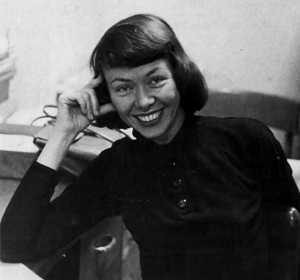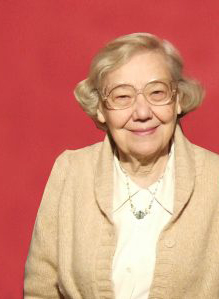Related Research Articles

Judy Chicago is an American feminist artist, art educator, and writer known for her large collaborative art installation pieces about birth and creation images, which examine the role of women in history and culture. During the 1970s, Chicago founded the first feminist art program in the United States at California State University, Fresno and acted as a catalyst for feminist art and art education. Her inclusion in hundreds of publications in various areas of the world showcases her influence in the worldwide art community. Additionally, many of her books have been published in other countries, making her work more accessible to international readers. Chicago's work incorporates a variety of artistic skills, such as needlework, counterbalanced with skills such as welding and pyrotechnics. Chicago's most well known work is "The Dinner Party", which is permanently installed in the Elizabeth A. Sackler Center for Feminist Art at the Brooklyn Museum. "The Dinner Party" celebrates the accomplishments of women throughout history and is widely regarded as the first epic feminist artwork. Other notable art projects by Chicago include International Honor Quilt, The Birth Project, Powerplay, and The Holocaust Project. She is represented by Jessica Silverman gallery and Salon 94 gallery.

Womanhouse was a feminist art installation and performance space organized by Judy Chicago and Miriam Schapiro, co-founders of the California Institute of the Arts (CalArts) Feminist Art Program and was the first public exhibition of Art centered upon female empowerment. Chicago, Schapiro, their students, and women artists from the local community, including Faith Wilding, participated. Chicago and Schapiro encouraged their students to use consciousness-raising techniques to generate the content of the exhibition. Together, the students and professors worked to build an environment where women's conventional social roles could be shown, exaggerated, and subverted.
The Woman's Building was a non-profit arts and education center located in Los Angeles, California. The Woman's Building focused on feminist art and served as a venue for the women's movement and was spearheaded by artist Judy Chicago, graphic designer Sheila Levrant de Bretteville and art historian Arlene Raven. The center was open from 1973 until 1991. During its existence, the Los Angeles Times called the Woman's Building a "feminist mecca."

A.I.R. Gallery is the first all female artists cooperative gallery in the United States. It was founded in 1972 with the objective of providing a professional and permanent exhibition space for women artists during a time in which the works shown at commercial galleries in New York City were almost exclusively by male artists. A.I.R. is a not-for-profit, self-underwritten arts organization, with a board of directors made up of its New York based artists. The gallery was originally located in SoHo at 97 Wooster Street, and was located on 111 Front Street in the DUMBO neighborhood of Brooklyn until 2015. In May 2015, A.I.R. Gallery moved to its current location at 155 Plymouth St, Brooklyn, NY 11201.
Lucy Rowland Lippard is an American writer, art critic, activist, and curator. Lippard was among the first writers to argue for the "dematerialization" at work in conceptual art and was an early champion of feminist art. She is the author of 21 books on contemporary art and has received numerous awards and accolades from literary critics and art associations.

The feminist art movement in the United States began in the early 1970s and sought to promote the study, creation, understanding and promotion of women's art. First-generation feminist artists include Judy Chicago, Miriam Schapiro, Suzanne Lacy, Judith Bernstein, Sheila de Bretteville, Mary Beth Edelson, Carolee Schneeman, Rachel Rosenthal, and many other women. They were part of the Feminist art movement in the United States in the early 1970s to develop feminist writing and art. The movement spread quickly through museum protests in both New York and Los Angeles, via an early network called W.E.B. that disseminated news of feminist art activities from 1971 to 1973 in a nationally circulated newsletter, and at conferences such as the West Coast Women's Artists Conference held at California Institute of the Arts and the Conference of Women in the Visual Arts, at the Corcoran School of Art in Washington, D.C..

May Stevens was an American feminist artist, political activist, educator, and writer.
Vera Klement is an American artist, and Professor Emerita at the University of Chicago. She was a 1981 Guggenheim Fellow.
The Women's Caucus for Art (WCA), founded in 1972, is a non-profit organization based in New York City, which supports women artists, art historians, students, educators, and museum professionals. The WCA holds exhibitions and conferences to promote women artists and their works and recognizes the talents of artists through their annual Lifetime Achievement Award. Since 1975 it has been a United Nations-affiliated non-governmental organization (NGO), which has broadened its influence beyond the United States. Within the WCA are several special interest causes including the Women of Color caucus, Eco-Art Caucus, Jewish Women Artist Network, International Caucus and the Young Women's Caucus. The founding of the WCA is seen as a "great stride" in the feminist art movement.
Cynthia Carlson is an American visual artist, living and working in New York.

HERESIES: A Feminist Publication on Art and Politics was a feminist journal that was produced from 1977 to 1993 by the New York-based Heresies Collective.
Mary Beth Edelson was an American artist and pioneer of the feminist art movement, deemed one of the notable "first-generation feminist artists." Edelson was a printmaker, book artist, collage artist, painter, photographer, performance artist, and author. Her works have been shown at the Museum of Modern Art, the Smithsonian American Art Museum, and the Museum of Contemporary Art in Chicago.
Women's Art Resources of Minnesota (WARM) is a women's art organization based in the U.S. state of Minnesota. It was founded in 1976 as Women's Art Registry of Minnesota, a feminist artist collective. The organization ran the influential WARM Gallery in downtown Minneapolis from 1976 to 1991.
Ad Hoc Committee of Women Artists or Ad Hoc Women Artists' Committee was founded in 1970 and included members from Women Artists in Revolution (WAR), the Art Workers' Coalition (AWC) and Women Students and Artists for Black Art Liberation (WSABAL). Founding members included Lucy Lippard, Poppy Johnson, Brenda Miller, Faith Ringgold and later, Nancy Spero.
Artemisia Gallery was an alternative exhibition space in Chicago, Illinois, that operated from 1973 until its closure in 2003.

The Women's Interart Center was a New York City–based multidisciplinary arts organization conceived as an artists' collective in 1969 and formally delineated in 1970 under the auspices of Women Artists in Revolution (WAR) and Feminists in the Arts. In 1971, it found a permanent home on Manhattan's far West Side. A trailblazing women's alternative space, the Center provided exhibition and performance venues, workshops, and training courses for artists in a wide range of media for over four decades, with a focus on developing women's skills, bringing their work to the public, and fostering innovation. Prominent visual artists exhibited at the Interart Gallery, which in 1976 mounted the first ever festival of black women's film. The Interart Theatre—the Center's off-off-Broadway stage—and its productions won numerous honors. The Center hosted the Women's Video Festival for several years and ran a video program responsible for a variety of notable works.

The Conference of Women in the Visual Arts was an event held on April 20, 1972, through 22, 1972 at the Corcoran Gallery of Art in Washington DC. The conference was organized by Cynthia Bickley, Mary Beth Edelson, Barbara Frank, Enid Sanford, Susan Sollins, Josephine Withers, and Yvonne Wulff. The impetus behind the conference was anger over the complete lack of women represented at the Corcoran Biennial the previous year, 1971. The three day conference consisted of lectures and panels of women artists and art historians. It was attended by over 300 female artists, art historians, critics and museum curators.
The Women's Art Movement (WAM) was an Australian feminist art movement, founded in Sydney in 1974, Melbourne in 1974, and Adelaide in 1976.

Alice Shaddle Baum was an American sculptor, collage artist, and founding member of the Artemisia Gallery in Chicago.
Sherry Brody was an American artist and pioneering member of the feminist art movement. Brody is known for her work on the Womanhouse project. Her sculpture, The Dollhouse, is in the Smithsonian Museum of American Art collection.
References
- 1 2 3 4 Moravec, Michelle (2012). "Toward A History Of Feminism, Art, And Social Movements In The United States". Frontiers: A Journal of Women Studies. 33 (2): 22–54. doi:10.5250/fronjwomestud.33.2.0022. JSTOR 10.5250/fronjwomestud.33.2.0022. S2CID 141537252.
- ↑ "Lucy Lippard". Profile. Video Data Bank, School/Art Institute Chicago. 1–2. 1981.
- ↑ Love, Barbara J., ed. (2006). Feminists who Changed America, 1963-1975 . Urbana, Ill.: Univ. of Illinois Press. p. 269. ISBN 0-252-03189-X.
west east bag.
- ↑ Brown, Meredith A. (8 January 2012). "'The Enemies of Women's Liberation in the Arts Will be Crushed': A.I.R. Gallery's Role in the American Feminist Art Movement". Archives of American Art.
- ↑ Lippard, Lucy R. (2002). "Biting the Hand: Artists and Museums in New York since 1969". In Ault, Julie (ed.). Alternative Art, New York, 1965–1985: A Cultural Politics Book for the Social Text Collective. Minneapolis: University of Minnesota Press. p. 96. ISBN 0-8166-3794-6.
- ↑ Hardenburgh, Linn; Duchon, Susan (Summer 1976). "In Retrospect – The Midwest Women Artists' Conference". Art Journal. 35 (4): 386. doi:10.1080/00043249.1976.10793312. JSTOR 776233.